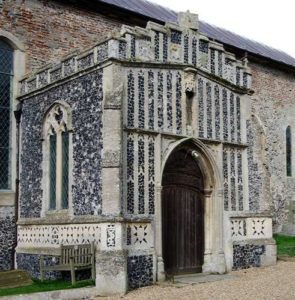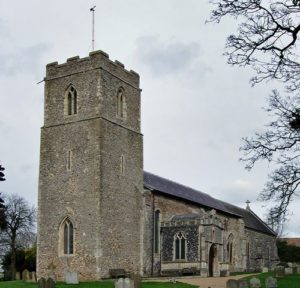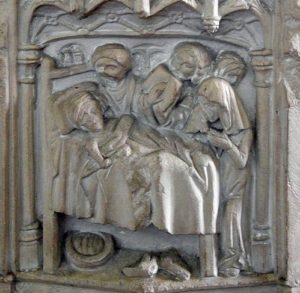Badingham is a long straggling village just off the A1120. The church is at the end of the village set on the hillside above the road. Built of flint it has the typical Suffolk tall square tower with a lower nave and chancel. The church has Norman origins but was rebuilt in the 13thC. The south porch is later and has an ornate flushwork facade. The church was extensively restored in the 19thC when the chancel was rebuilt using knapped flint rather than rough nodules. This makes it look much darker than the rest of the church.
Entry is through the south door. Don’t miss the delightful carving of a cat inside the porch and another of a man supporting a stone roof.
Inside it is a fairly plain church. With no side aisles it is small and homely. Built on the side of a hill, the church slopes up to the altar which is reached up steps.
Walls are plastered and painted. There is a hammer beam roof in the nave with angels holding scrolls. These are 19thC replacements of angels destroyed by the iconoclasts.
At the back of the church is a Seven Sacrament font dating from 1480s. This is one of only thirteen to survive the Iconoclasts in Suffolk. Round the base are carved figures under ogee arches. The carvings on the panels of the bowl represent mass, penance, last rite, Christ’s baptism by John the Baptist, matrimony, holy orders and confirmation. I particularly liked the scene with the Last Rites with the dying man’s shoes and chamber pot under the bed and his wife crying into a hankie. In the baptism scene, the mother is holding a Chrisom cloth to wrap the baby in.
There is a wooden screen across the base of the tower. A long wooden ladder gives access to the bell chamber. On the wall of the tower are painted panels with the Lord’s Prayer and Ten Commandments. At the back are some medieval pews with carved poppy heads. The rest of the pews are 19thC. At the bottom of the steps leading to the altar is a wooden pulpit with sounding board above and a reading desk.
There are carved wooden choir stalls in the chancel and a small organ. Beneath the 19thC stained glass window is a table altar with a small carved stone reredos.
On the north wall is the splendid tomb of William Cotton and his wife Lucie, dressed in black and with two small praying figures of their children beneath. He is on the far side of the tomb and raised up slightly above his wife so he can be seen. On the back wall are two arches with cherub heads above unreadable slate memorial stones. The canopy decorated with red flowers is supported by two pillars covered with painted coats of arms. At the top is a small figure holding a shield. It is a splendid tomb for a small church.
To the left is the remains of another tomb with a canopy above a carved base with blank shields on it. There are later memorials on the wall of the church.
This is a delightful church, small and intimate. There is nothing really special about it but we liked it. We found this for many of the smaller Suffolk churches and we often preferred them to the big splendid wool churches.
There is a small parking area opposite the church which is always open.










